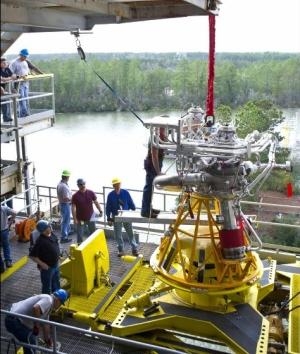Fri, Jan 27, 2012
First New 'Human Rated' Engine To Be Developed In Four
Decades
A new series of tests on NASA's new J-2X engine will begin next
week at NASA's Stennis Space Center in southern Mississippi. NASA
says the tests on the engine bring it one step closer to the first
human-rated liquid oxygen and liquid hydrogen rocket engine to be
developed in 40 years.

Tests will focus on the powerpack for the J-2X. This
highly efficient and versatile advanced rocket engine is being
designed to power the upper stage of NASA's Space Launch System, a
new heavy-lift launch vehicle capable of missions beyond low-Earth
orbit. The powerpack comprises components on the top portion of the
engine, including the gas generator, oxygen and fuel turbopumps,
and related ducts and valves that bring the propellants together to
create combustion and generate thrust. "The J-2X upper stage engine
is vital to achieving the full launch capability of the
heavy-lift Space Launch System," said William Gerstenmaier, NASA's
associate administrator for the Human Exploration and Operations
Mission Directorate. "The testing today will help ensure that a key
propulsion element is ready to support exploration across the solar
system."
About a dozen powerpack tests of varying lengths are slated now
through summer at Stennis' A-1 Test Stand. By separating the engine
components -- the thrust chamber assembly, including the main
combustion chamber, main injector and nozzle -- engineers can more
easily push the various components to operate over a wide range of
conditions to ensure the parts' integrity, demonstrate the safety
margin and better understand how the turbopumps operate.
"By varying the pressures, temperatures and flow rates, the
powerpack test series will evaluate the full range of operating
conditions of the engine components," said Tom Byrd, J-2X engine
lead in the SLS Liquid Engines Office at NASA's Marshall Space
Flight Center in Huntsville, Ala. "This will enable us to verify
the components' design and validate our analytical models against
performance data, as well as ensure structural stability and verify
the combustion stability of the gas generator."
This is the second powerpack test series for J-2X. The powerpack
1A was tested in 2008 with J-2S engine turbomachinery originally
developed for the Apollo Program. Engineers tested these heritage
components to obtain data to help them modify the design of the
turbomachinery to meet the higher performance requirements of the
J-2X engine. "The test engineers on the A-1 test team are excited
and ready to begin another phase of testing which will provide
critical data in support of the Space Launch System," said Gary
Benton, J-2X engine testing project manager at Stennis.
More News
Aero Linx: Transport Canada We are a federal institution, leading the Transport Canada portfolio and working with our partners. Transport Canada is responsible for transportation p>[...]
Gross Navigation Error (GNE) A lateral deviation from a cleared track, normally in excess of 25 Nautical Miles (NM). More stringent standards (for example, 10NM in some parts of th>[...]
From AirVenture 2017 (YouTube Edition): Flight-Proven Booster On Display At AirVenture… EAA AirVenture Oshkosh is known primarily as a celebration of experimental and amateu>[...]
Aircraft Parachute System (CAPS) Was Deployed About 293 Ft Above Ground Level, Which Was Too Low To Allow For Full Deployment Of The Parachute System Analysis: The day before the a>[...]
Also: 48th Annual Air Race Classic, Hot Air Balloon Fire, FAA v Banning 100LL, Complete Remote Pilot The news Piper PA-18 Super Cub owners have been waiting for has finally arrived>[...]
 ANN's Daily Aero-Linx (06.29.25)
ANN's Daily Aero-Linx (06.29.25) ANN's Daily Aero-Term (06.29.25): Gross Navigation Error (GNE)
ANN's Daily Aero-Term (06.29.25): Gross Navigation Error (GNE) Classic Aero-TV: Anticipating Futurespace - Blue Origin Visits Airventure 2017
Classic Aero-TV: Anticipating Futurespace - Blue Origin Visits Airventure 2017 NTSB Final Report: Cirrus SR22
NTSB Final Report: Cirrus SR22 Airborne Affordable Flyers 06.26.25: PA18 Upgrades, Delta Force, Rhinebeck
Airborne Affordable Flyers 06.26.25: PA18 Upgrades, Delta Force, Rhinebeck



